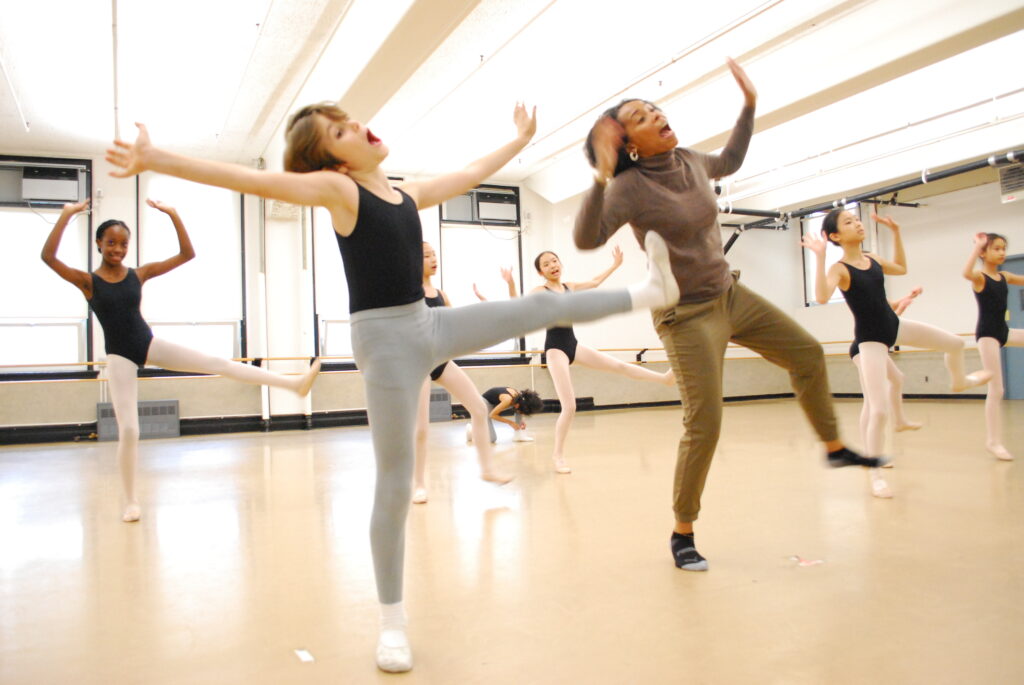

Since 2021, Dionne Figgins has led Ballet Tech, New York City’s Public School for Dance, which operates in tandem with the NYC Department of Education. Children across NYC’s boroughs have received not only intensive ballet training but lessons in modern dance, tap, jazz, theater dance, and choreographic repertory. And graduates have gone on to perform with leading dance companies, as well as other careers throughout the performing arts.
Figgins received her dance training at the Jones-Haywood School of Ballet in Washington, DC (now known as the Jones-Hayward Dance School), under Doris Jones and Sandra Fortune-Green. During her performing career, she was a member of the Dance Theatre of Harlem under Arthur Mitchell, and danced lead roles in George Balanchine’s works, such as Serenade, Four Temperaments, Agon, and Concerto Barocco. Her Broadway credits include Hot Feet, Memphis, Leap of Faith (assistant choreographer) and Motown: The Musical.
Figgins chatted with Dance Teacher about what she enjoys most about working at Ballet Tech; what Arthur Mitchell taught her about the importance of humor in dance class; and her new program, Ballet Tech Across New York.
What is your favorite part of being artistic director of Ballet Tech?
I enjoy working with this age group of fourth-through-eighth–graders. I like this group because they ask a lot of questions. They still have access to their imaginations, so there is a lot of creative play in the studio, which I think is important because ballet can be very rigorous. I challenge myself to maintain the rigor that exists in ballet while simultaneously making it fun for the students. I try to offer programming that gives them a balance of ballet [and other classes], so they can understand that all of the hours they spend in the studio will lead them to fulfilling experiences onstage.
What do you believe is the biggest challenge facing dance educators now, and how do you navigate that?
Kids are consuming a lot of media, and they think that 30 seconds to one minute worth of content [on social media] from a dance perspective is the work. They don’t realize that sometimes you are dancing for 30 minutes or an hour. The challenge is developing stamina in students who are used to instant gratification. Their attention span isn’t there, not just in what they consume but also in their physical ability to stay focused in the training. There’s an idea that everything on social media and the internet looks easy, but there is hard work that’s required to make it look easy. I feel [as a teacher] that I’m on my feet more. I’m really in the practice with the students, trying to inspire them from the floor versus from the front of the room. It requires more effort to get the students inspired to do the work in this generation.
Have you had a role model in dance education?
My first teacher, Doris Jones, who founded Jones-Haywood School of Ballet in Washington, DC. She believed that regardless of whether a student was going to go into performative dance or not, there was something to be gained through this training. There are values that we learn in the studio, like discipline, beauty, integrity, curiosity, and creativity. She never left the students behind. Sometimes you’re in the studio and you know a kid isn’t going to dance or doesn’t want to do it. But how do you use dance to turn on the light switch of other creative modes? Dance is a way of being able to talk about other avenues, like costume design, physical therapy, etc. There are so many other ways we can be encouraging students to be involved in the dance world.
Another [mentor] is Hinton Battle. He came out of Jones-Haywood School of Ballet, and in my early 20s he took me under his wing. He knew how to get on the floor with the dancers. You didn’t feel like you were being dictated to from the front of the room. You felt like he was invested to the degree that he would also put his body through the work with you. It was very inspirational to see this artist, who has already accomplished a lot, pouring in so much in the studio and sweating alongside the dancers. It made you want to work a little harder, knowing that he was in it with you.

What’s the best advice you have received as a dance educator?
A sentiment that keeps coming up for me is “doing it scared.” Even if you don’t know all the answers, because none of us do, put yourself in the practice of doing it anyway. You’ll find the answers through the practice of doing. And being open to learning along the way. There are so many things that I’m uncertain of sometimes because I am dealing with children, but what I do know is how to dance. I do know how to inspire children.
What is your new Ballet Tech Across New York program?
Since the beginning of Ballet Tech, there has always been a program where we go into the NYC school system and identify students that may be good to receive additional training in ballet. That used to be an audition program. It was really based on going in and holding auditions with the students. I thought to myself that if I was being introduced to dance through an audition process, I might not be able to enjoy it as much because I would be so concerned with being picked.
So we wanted to take that out of the equation and instead do a class. Instead of making it feel like an audition, where the students are being selected and we’re taking a lot of copious notes, I wanted this to feel like an enrichment class for second- and third-graders. We begin to introduce the things that they would learn if they came to Ballet Tech. During the enrichment class, we begin to identify students that we think may be good to come for our six-week Introduction to Ballet program. The students don’t necessarily know that there is a selection process. From their perspective, they know they’ve come in to have a good experience with dance for the day.
What’s your “one thing” that you always like to integrate when you are teaching class?
Comedy. One hundred percent. One of my other teachers and role models, Mr. Arthur Mitchell, was a master of using wit and comedy with the dancers. If he could get you to laugh at your mistakes instead of cry, he knew he’d be able to move you further into your work. I try to make light of the areas where students may find themselves falling short, so that they don’t crumble and can move on. I also get students to give themselves positive affirmations. Before we start barre, I like to ask the students what is one thing they want to achieve during class and set their intention. And then I give them the opportunity to celebrate their wins. I want them to learn how to validate themselves in this space, so they aren’t constantly looking for that from the front of the room. When you work hard, that should be its own reward.
What is your advice for today’s dance educators?
Be patient with your students. Working with fourth- to eighth-grade students, they are in the beginning stage of their training, so we don’t always get to see the fruit of our work. People want to see the finished product, the ballerina they are pouring all this energy into. But at the fourth- to eighth-grade levels, you’re not going to see it yet. It’s more reinforcing information every day. It requires a lot of patience to work with this age group because they want to know how everything works and ask endless questions. So I try to answer all their questions and really explain how the world works to them because we are developing human beings, not just dancers.





